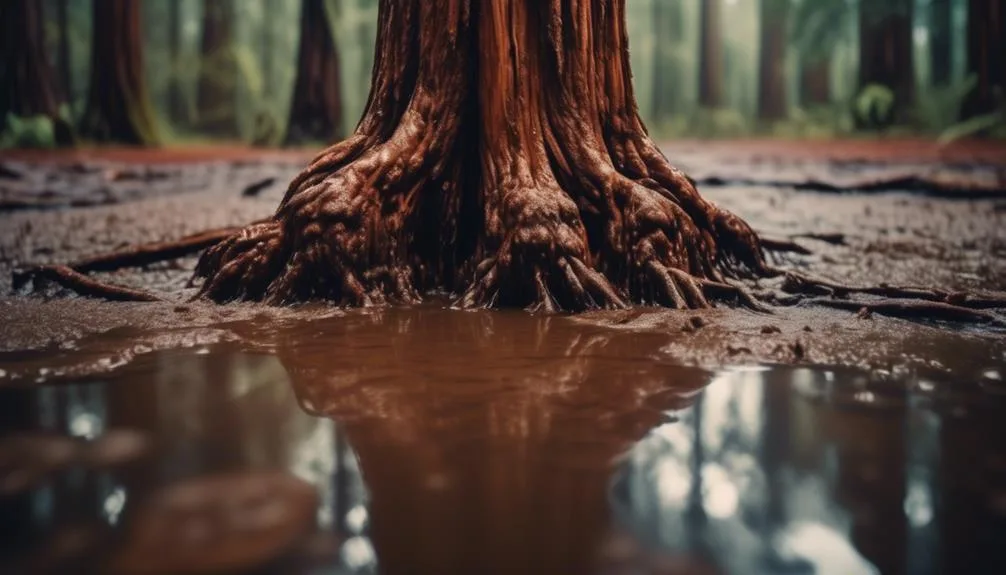Do redwood trees really thrive in wet soil? Picture them as sturdy ships sailing through soggy terrain. Their ability to survive and adapt to these conditions is truly remarkable. From their roots to their towering crowns, redwood trees have developed impressive strategies to endure in wet soil.
Nature's ingenuity is on full display in their survival mechanisms. But what exactly enables these majestic giants to withstand the challenges of such damp surroundings?
Optimal Soil Conditions for Redwood Trees
To ensure the optimal growth of redwood trees, the soil conditions should be well-draining and rich in organic matter.
Soil acidity plays a crucial role in the development of redwood tree roots. These trees thrive in slightly acidic to neutral soil, with a pH range of 5.5 to 7.0. If the soil becomes too acidic, it can hinder the uptake of essential nutrients, leading to poor root development. Conversely, excessively alkaline soil can also impede nutrient absorption.
Therefore, maintaining the right soil acidity is vital for fostering robust root systems in redwood trees.
Additionally, ensuring that the soil is well-draining prevents waterlogging, which can suffocate the roots and inhibit their growth.
Effects of Wet Soil on Redwood Trees
Excessive moisture in the soil can significantly impact the health and survival of redwood trees. Wet soil can lead to root rot, a fungal disease that affects the roots and can eventually kill the tree. The prolonged presence of water in the soil reduces the oxygen available to the roots, leading to their decay and making the tree more susceptible to diseases.
Additionally, growth stunting is a common effect of wet soil on redwood trees. When roots are unable to access the necessary nutrients due to waterlogged soil, the overall growth and development of the tree is hindered.
It's crucial to ensure proper drainage and avoid overwatering to prevent these detrimental effects on redwood trees. By addressing soil moisture levels, you can help promote the health and resilience of these majestic trees.
Adaptability of Redwood Trees to Wet Environments
Redwood trees demonstrate remarkable adaptability to wet environments, showcasing their ability to thrive in challenging conditions. This wetland adaptation is attributed to their unique tree physiology, which includes features that enable them to tolerate high levels of water.
Redwoods have developed hydrological tolerance, allowing them to withstand prolonged periods of saturated soil. One key factor contributing to their adaptability is their root systems, which are adept at extracting oxygen from waterlogged soils. The roots of redwood trees can extend horizontally for great distances, helping them to access oxygen and nutrients even in wet conditions.
Additionally, their fine, shallow roots enable efficient water uptake, aiding in their ability to flourish in these environments. This adaptability is a testament to the impressive resilience and survival strategies of redwood trees in wet soil.
Strategies for Redwood Trees in Wet Soil
Considering the challenges posed by persistently wet soil, redwood trees employ a range of strategic adaptations to ensure their survival and growth in these environments.
One key strategy is the development of specialized root systems. Redwoods have shallow, wide-spreading roots that can absorb oxygen from the surface of the soil, allowing them to thrive in wet conditions where oxygen levels are low.
Additionally, these roots intertwine with the roots of neighboring redwoods, providing mutual support and stability in waterlogged soil.
Moreover, redwood trees have evolved a unique ability to form pneumatophores, or aerial roots, which emerge from the water to access air, facilitating gas exchange and aiding in the uptake of oxygen.
Redwood Tree Survival in Wet Soil
In persistently wet soil, the survival of redwood trees hinges on their specialized root systems, which enable them to thrive in low-oxygen environments through strategic adaptations. Redwoods are susceptible to root rot in waterlogged conditions, which can jeopardize their survival. To mitigate this risk, proper drainage is crucial.
Redwood trees have a shallow root system that spreads widely, allowing them to capture surface water efficiently. In wet soil, the composition becomes a critical factor. Redwoods thrive in soils with good drainage and rely on a mix of organic matter and coarse materials to maintain oxygen levels around their roots.
Understanding the specific soil requirements and implementing measures to ensure adequate drainage is essential for the long-term survival of redwood trees in persistently wet conditions.
Conclusion
In summary, redwood trees demonstrate remarkable adaptability, thriving in both well-drained and waterlogged soil.
Their ability to flourish in diverse conditions raises intriguing questions about their resilience and the broader implications for forest ecosystems.
Mark Hoffman is a dedicated arborist and tree care specialist with over a decade of experience. His love for trees began when he visited Yosemite National Park as a teenager and was awestruck by the giant sequoias. Mark pursued his passion by studying forestry at Michigan Technological University, where he earned a Bachelor of Science degree.
Since then, he has worked tirelessly in the field of arboriculture, helping to preserve and protect trees in his community. His expertise and dedication have made him a respected leader in the industry and a valuable resource for anyone seeking advice on tree care.
